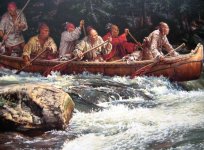mikemiller1955
Lieutenant General
- Joined
- Aug 3, 2008
- Messages
- 17,619
Also from Lord Nelson's Gallery....Robert Griffing

Fragile Trust...by Robert Griffing

Friend or Foe...by Robert Griffing
Here you see the everyday reality of survival in these times, warriors on patrol discerning if the tracks in the snow indicate a possible enemy threat.

He Befriended Me...by Robert Griffing
Major James Grant's September 1758 sortie on Fort Duquesne (now Pittsburgh)was met unexpectedly by spirited French and Indian resistance. In the ensuing carnage, Private Robert Kirkwood of the 77th Highland Regiment was pursued by four Indians and wounded. He later wrote that,"I was immediately taken, but the Indian who laid hold of me would not allow the rest to scalp me, tho' they proposed to do so. In short, he befriended me greatly."

Pursued...by Robert Griffing

Brothers Of The Forest by Robert Griffing
Even though the great Iroquois Confederacy was in a state of decline, the Seneca warrior still maintained his reputation for military ferocity. His close relationship to the forest around him provided a distinct advantage over Europeans who were unfamiliar with his woodland skills and war tactics.

Logan's Revenge by Robert Griffing
Talgayeeta, better known as Chief Logan of the Mingo whose capacity for fairness and honorable conduct was well documented, was an advocate of peace. After his father Shickellamy's death, Logan became one of the ten leading Sachems or council chiefs of the Cayuga (Seneca) branch. Logan eventually left the Cayugas to become chief of the Mingos where he lived with his family at the mouth of Yellow Creek, near present day Stubenville, OH.
"Who is there to mourn for Logan?...Not one!" were the final words of Logan's Lament, his famous speech given to Lord Dunmore which summed up the feelings of anger and frustration over the brutal murders of his family by a party of disreputable frontiersmen. Upon discovery of his family's bodies, Logan swore revenge and within a short time, began reprisals on the scattered white settlers in the Ohio valley. The moving and emotional speech Logan's Lament is printed in its entirety at the bottom of each limited edition print.

Long Way From Home by Robert Griffing
As this Highlander plays the melancholy music of his fiddle, he can't help but be reminded that he's a Long Way From Home.

Fragile Trust...by Robert Griffing

Friend or Foe...by Robert Griffing
Here you see the everyday reality of survival in these times, warriors on patrol discerning if the tracks in the snow indicate a possible enemy threat.

He Befriended Me...by Robert Griffing
Major James Grant's September 1758 sortie on Fort Duquesne (now Pittsburgh)was met unexpectedly by spirited French and Indian resistance. In the ensuing carnage, Private Robert Kirkwood of the 77th Highland Regiment was pursued by four Indians and wounded. He later wrote that,"I was immediately taken, but the Indian who laid hold of me would not allow the rest to scalp me, tho' they proposed to do so. In short, he befriended me greatly."

Pursued...by Robert Griffing

Brothers Of The Forest by Robert Griffing
Even though the great Iroquois Confederacy was in a state of decline, the Seneca warrior still maintained his reputation for military ferocity. His close relationship to the forest around him provided a distinct advantage over Europeans who were unfamiliar with his woodland skills and war tactics.

Logan's Revenge by Robert Griffing
Talgayeeta, better known as Chief Logan of the Mingo whose capacity for fairness and honorable conduct was well documented, was an advocate of peace. After his father Shickellamy's death, Logan became one of the ten leading Sachems or council chiefs of the Cayuga (Seneca) branch. Logan eventually left the Cayugas to become chief of the Mingos where he lived with his family at the mouth of Yellow Creek, near present day Stubenville, OH.
"Who is there to mourn for Logan?...Not one!" were the final words of Logan's Lament, his famous speech given to Lord Dunmore which summed up the feelings of anger and frustration over the brutal murders of his family by a party of disreputable frontiersmen. Upon discovery of his family's bodies, Logan swore revenge and within a short time, began reprisals on the scattered white settlers in the Ohio valley. The moving and emotional speech Logan's Lament is printed in its entirety at the bottom of each limited edition print.

Long Way From Home by Robert Griffing
As this Highlander plays the melancholy music of his fiddle, he can't help but be reminded that he's a Long Way From Home.









